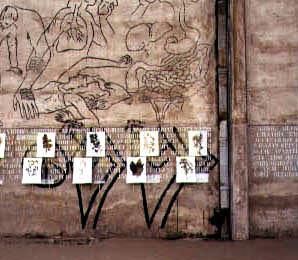

|

Carlos Vergara's work consisted in identifying the several species of medicinal herbs that flourish in the lots along the railway. The plant beds are demarcated by colored flags fixed on posts spread by the places and aligned to the rails. They correspond to the human-body organs benefited by each medicinal herb. A great crop of this material was also made in the area, allowing the assembly of a pharmacy _ a herbarium _ where herbs are presented in prepared potions. A botany of the asphalt. A typical way of the 17th and 18th centuries' scientism of mapping an area: through the reconstruction of its flora. The succession of species demarcating the land's continuity. Cataloguing obsessively and, at the same time, inconsequentially. An inventory that refers to the action of European scientific expeditions like Langsdorff's, that traveled all over Brazil. The anachronous paradox of a botanical expedition in the metropolis' heart.
    A mapping of the city through its herbs, the weeds growing between stones of abandoned buildings. The principles of botany and pharmacology _ foundations of the scientistic mapping of the natural flora and of the human body _, here transformed into cartographic instruments for the city.
A mapping of the city through its herbs, the weeds growing between stones of abandoned buildings. The principles of botany and pharmacology _ foundations of the scientistic mapping of the natural flora and of the human body _, here transformed into cartographic instruments for the city.

|
|